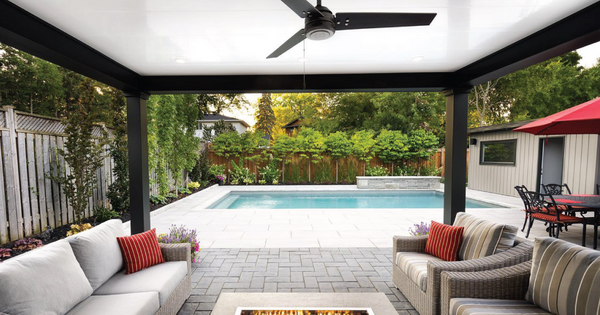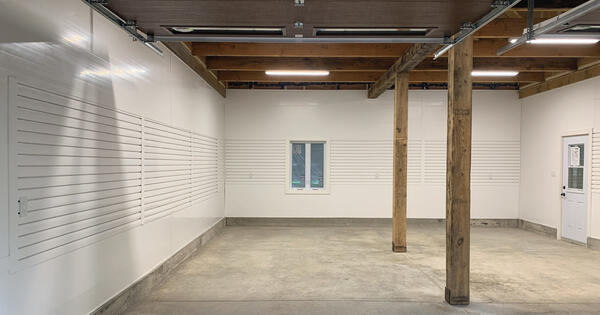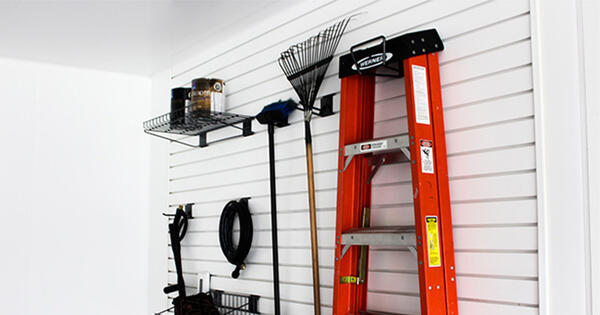Peel-and-stick wallpaper is self-adhesive and offers an easy way to add color, patterns, or textures to your space without the mess of traditional wallpaper or long drying times.
If you plan to install peel-and-stick wallpaper yourself, follow the tips in this blog post to ensure a picture-perfect project.



Benefits of Peel-and-Stick Wallpaper
Peel-and-stick wallpaper offers many benefits that make it an attractive choice for homeowners and renters alike. Here's a closer look at some of the perks of peel-and-stick wallpaper:
- Easy Installation: Unlike traditional wallpaper that requires messy paste and lengthy drying times, peel-and-stick wallpaper is incredibly easy to install. With its self-adhesive backing, you can simply peel off the backing paper and stick the wallpaper directly onto the wall, saving you time, mess, and effort.
- No Residue: One of the biggest concerns with traditional wallpaper is the residue it leaves behind when removed. Peel-and-stick wallpaper, however, can be easily removed without leaving any sticky residue or damaging the wall surface. This makes it an ideal option for renters who want to personalize their space without risking their security deposit.
- Versatility: Peel-and-stick wallpaper comes in a wide range of designs, patterns, and textures, allowing you to customize your space to suit your personal style. Whether you prefer bold and vibrant patterns or subtle textures, there's a peel-and-stick wallpaper option to match your aesthetic preferences.
- Damage-Free: Traditional wallpaper installation often involves scraping and sanding the walls beforehand, which can cause damage to the wall surface. Peel and stick wallpaper, on the other hand, can be applied directly to smooth, clean walls without any prep work, minimizing the risk of damage.
- Cost-Effective: Peel-and-stick wallpaper is a cost-effective alternative to traditional wallpaper, especially when factoring in the savings on labor and installation costs. With peel-and-stick wallpaper, you can achieve professional-looking results on a budget, making it an ideal option for DIY enthusiasts and budget-conscious homeowners.

Preparing Your Wall for Peel-and-Stick Wallpaper
Before you dive into the world of peel-and-stick wallpaper, it's important to prepare your walls properly. Proper preparation ensures a smooth and seamless installation and helps prolong the lifespan of your wallpaper.
- Clean the Surface: Start by thoroughly cleaning the walls to remove any dirt, dust, or grease. A mixture of warm water and mild detergent works wonders for this task. Be sure to allow the walls to dry completely before moving on to the next step.
- Repair Imperfections: Take the time to inspect the walls for any imperfections, such as cracks, holes, or uneven surfaces. Patch up any holes with spackling paste and sand down any rough areas until the walls are smooth and even.
- Smooth and Dry: Lastly, ensure that the walls are completely dry before applying the wallpaper. Moisture can prevent the adhesive from sticking properly, leading to bubbles or peeling later. Allow freshly cleaned or repaired walls to dry for at least 24 hours before proceeding.
Measuring and Cutting Peel-and-Stick Wallpaper
One of the keys to a successful peel-and-stick wallpaper installation is accurate measurements and precise cutting.
- Measure Twice, Cut Once: Take the time to measure the dimensions of your walls accurately. Use a tape measure to determine the height and width of each wall, and don't forget to account for any windows, doors, or other obstacles.
- Cutting Techniques: When it comes to cutting the wallpaper to fit, a sharp utility knife and a straight edge are your best friends. Lay the wallpaper flat on a clean surface, measure and mark your cuts carefully, and use the straight edge to guide your knife for clean, straight lines.
Peel-and-Stick Wallpaper Application
Now comes the fun part – applying the wallpaper to the wall! Let's dive into the step-by-step process to ensure a smooth and successful installation.
- Starting Point: Begin by peeling off a small section of the backing paper from the top corner of your first wallpaper panel. It's crucial to start in a corner or along an edge for a neat finish. Make sure to peel the backing paper away slowly and steadily to avoid tearing or stretching the wallpaper.
- Positioning: Once you've exposed a portion of the adhesive backing, carefully align the top edge of the wallpaper with the top corner of the wall. Take your time to ensure the alignment is perfect before pressing the adhesive firmly onto the wall. Remember, the initial placement is key to achieving a straight and uniform installation.
- Smoothing Out: As you continue to peel away the backing paper and press the wallpaper onto the wall, use a plastic smoothing tool or a clean, dry cloth to smooth out any air bubbles or wrinkles. Work from the center outwards, applying gentle pressure to ensure the adhesive bonds securely to the wall surface.
- Working in Sections: Depending on the size of your wallpaper panels and the dimensions of your walls, you may need to work in sections to cover the entire surface. When transitioning from one section to the next, carefully align the edges of the panels to maintain a seamless appearance. Avoid overlapping or leaving gaps between panels for a professional finish.
- Adjustment: If you encounter any misalignment or uneven placement while applying the wallpaper, don't worry. Peel back the affected area gently and reposition it as needed. The adhesive backing allows for easy adjustments without damaging the wallpaper or the wall surface.
- Addressing Air Bubbles: Despite your best efforts, you may still encounter stubborn air bubbles or wrinkles during the application process. If this happens, use a pin or needle to puncture the bubble carefully. Then, gently press the surrounding area to release the trapped air and smooth out the wallpaper. Avoid using excessive force to prevent damaging the wallpaper.
- Seamless Transitions: When overlapping wallpaper panels or transitioning between sections, aim for seamless transitions to maintain continuity in the pattern or design. Carefully align the edges of the panels and ensure they blend seamlessly into each other for a polished look.
- Trimming Around Obstacles: Use a sharp utility knife or scissors to trim away any excess wallpaper around obstacles like outlets, switches, or corners, use a sharp knife or scissors to carefully cut around them, and leave a small overlap for a seamless finish.
- Final Inspection: Once you've covered the entire wall surface with peel-and-stick wallpaper, take a step back and inspect the installation carefully. Look for any areas that may require additional smoothing or adjustment. Address any imperfections promptly to achieve a flawless finish.
Maintaining Peel-and-Stick Wallpaper
Congratulations—your peel-and-stick wallpaper is installed and looking fabulous! Now, let's discuss how to keep it looking its best for years to come.
- Gentle Cleaning: To clean your peel-and-stick wallpaper, simply wipe it down with a damp cloth or sponge. Avoid using harsh chemicals or abrasive cleaners, as these can damage the adhesive or the wallpaper's surface.
- Addressing Issues: If you notice any peeling edges or stubborn stains, don't panic. Simply use a small amount of adhesive or double-sided tape to reattach any loose edges, and gently blot away stains with a mild detergent and water.
Troubleshooting Issues When Installing Peel-and-Stick Wallpaper
Even with careful preparation and installation, you may encounter some common problems along the way. Here's how to tackle them like a pro:
- Wrinkles and Bubbles: If you notice any wrinkles or bubbles in your wallpaper, lift the affected area and smooth it out with your hands or a smoothing tool. If the issue persists, use a hairdryer on a low heat setting to gently warm the adhesive and reapply the wallpaper.
- Misalignment: If you accidentally misalign a panel or pattern during installation, don't panic. Simply peel back the affected area and realign it with the adjacent panels for a seamless finish.
As you embark on your peel-and-stick wallpaper installation journey, remember to take your time and be patient. With the right preparation, tools, and techniques, you can achieve professional-looking results that will transform your space quickly.

Enhancing Trusscore Wall&CeilingBoard with Peel-and-Stick Wallpaper
Peel-and-stick wallpaper can also be installed on PVC panels like Trusscore Wall&CeilingBoard so you can enjoy the durability and water-resistant benefits of the product and the aesthetics of available wallpaper designs.
Luckily, the steps to apply peel-and-stick wallpaper to Trusscore panels are largely the same as on standard surfaces like drywall. For peace of mind, here’s a quick summary of the steps and special considerations to take when installing peel-and-stick wallpaper on Trusscore:
- Ensure Trusscore Wall&CeilingBoard panels are clean, dry, and free of dust.
- Measure the wallpaper against the panel area and cut it to size. We recommend extending the width of the wallpaper beyond the width of the Trusscore Wall&CeilingBoard panels to ensure the seams of the wallpaper don’t align with the edges of the panels.
- Carefully peel the wallpaper backing and adhere to the panel. Overlap seams for a continuous pattern flow and avoid extreme temperatures for optimal adhesion.
- Trim any excess wallpaper using a sharp knife or blade.
If needed, apply a mixture of soap and water (e.g., 3 to 4 drops of liquid soap combined with 16 ounces of water) with a hand sprayer to your Trusscore Wall&CeilingBoard panel to make it easier to apply and adjust the wallpaper. Note: This only works for vinyl peel-and-stick wallpaper.
And that’s all!
Peel-and-stick wallpaper is a game-changer for homeowners and renters alike. With its easy installation, versatile designs, and hassle-free removal, it's no wonder it's becoming a popular choice for DIY enthusiasts everywhere. Armed with the tips and techniques outlined in this guide, you'll be well-equipped to tackle your next home decor project with confidence. Happy decorating!






